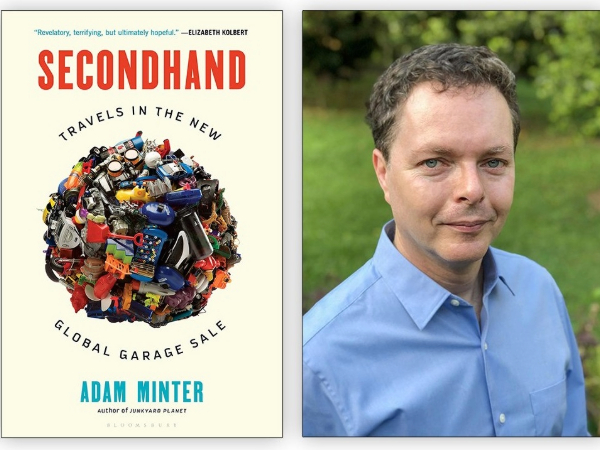
“Growing affluence across the developing world means that more and more consumers are opting for new stuff,” writes Adam Minter in his book Secondhand: Travels in the New Global Garage Sale (Bloomsbury USA, 320 pages).
A diverse, multi-billion-dollar industry is associated with reusing things that people once purchased but no longer want to possess. Some of us will hold the occasional garage sale or trade in a used car, and most of us will occasionally drop off unwanted items at a Goodwill store. But the full extent of the trade in used goods is invisible to us. In his book, Adam Minter shines a light on the resourceful people who make a living getting things out of the hands of those who no longer want them and into the hands of those who do.
While Latin Americans may aspire to the consumer lifestyle of their neighbors to the north, many in Southeast Asia see Japan’s wealth and income as their goal. However, until they can afford new items, used goods will bridge the gap. While Malaysia’s economy has been successful, per capita household income there remains less than one-third of Japan’s.
According to Minter: “As a result, many Malaysians buy secondhand if they have any hope of emulating the Japanese lifestyle.” Though the book is well-researched and full of data, Minter reveals the big-picture narrative through the individual stories of a compelling cast of characters. Enter Jeongja Han, a 50-year-old retired flight attendant and director of a company that “specializes in cleaning out and disposing of the property accumulated by Japan’s shrinking population.” She is accredited in shukatsu, which is “the process of preparing for the end.” And, while she could price each job for labor, truck costs, and disposal fees to collect the material and deliver it to one of Japan’s high-tech incinerators, she says her clients “want to know that somebody is using their things. It makes them feel good.” She sells much of it to a 67-year-old man named Tetsuaki Muraoka, who ships it to the Philippines. Muraoka spent 20 years repairing PCs until smartphones ended that line of business.
Minter recalls a discussion between Han and Muraoka that illustrates the constant change in the industry: “‘The Filipino market won’t last forever,’ she tells him. ‘As the wealth level goes up, they’ll want new things. Then what?’ It’s happened before –– Thailand was once Japan’s favored destination for its used stuff. But that market has faded with Thailand’s increasing wealth. ‘Cambodia, probably,’ Han surmises.”
Across the globe in Arizona, Mike Mellors, a 57-year-old Goodwill attendant, tells Minter, “Goodwill is where Tucson’s garage salers unload things they can’t sell and don’t want to keep. It’s a weekly phenomenon boosted by the comings and goings of Tucson’s military families and retirees. When they arrive, they need things; later, they realize they can’t take it all with them.” The best of these donated items will be stocked on the shelves of a Goodwill store looking for a buyer. After six weeks of discounting there, about a third will sell.
Remaining unsold items are moved to a Goodwill Outlet Center and sold by the pound, where “80 to 90% of the customers are Mexicans purchasing goods bound for resale over the border.” Only 12% of the items received at the outlet center are sold there. Much of what is sold at garage sales, regular Goodwill stores, and the Goodwill Outlet Center enters the “Southwestern version of Japan’s trade with Southeast Asia… a trade conducted by small-business people who, pickup by pickup, evacuate the unwanted stuff generated across the Southwestern United States to Mexico’s up-and-coming consumers.”
One of those small-business people is “Shoe Guy,” a 41-year-old Mexican who logs 50,000 miles a year traveling between Tucson’s 16 Goodwill stores and Nogales, Mexico. “At Goodwill Industries of Southern Arizona, he’s considered a big buyer (which is saying something). On the other side of the border, he has a network of seven wholesale buyers, some of whom take as many as 100 pairs of shoes at a time,” writes Minter.
Anna and her sister are also active in this market. They buy goods daily from the Goodwill Outlet Store and warehouse them in their four-bedroom Tucson home. When they have a full load, they travel south to Hermosillo, Mexico, to restock their mother’s secondhand store. Business has been good, but according to the sisters, “the quality of clothes is decreasing. Used to be it’d take two or three days work and we’d have a load to send home. Now it takes six days to find the same amount of stuff.”
Goodwill will send much of what doesn’t sell at the stores or outlets to landfills. Textiles, however, are compressed into 500-pound bales and sold into the “salvage,” or export, market. Some go directly to traders in Pakistan, India, or West Africa. However, about one-third of the used clothing from the U.S. and Canada is sorted, priced, and shipped by “graders” operating in Mississauga, Ontario.
A recurring theme is the desire for more markets to move from quality secondhand goods to new goods of any quality. To counter this disruption, Minter argues, “Simple, voluntary steps by manufacturers and consumers to encourage the production of more durable and repairable goods could go a long way toward ensuring that secondhand thrives and grows for decades to come.”
“The most intractable barriers are prejudices that inhibit people in wealthy countries from selling and shipping their unwanted stuff to people in developing countries,” he writes. “There is no secondhand economy that excludes the developing world, and consumers in the wealthy, developed world need to embrace that reality.”
Adam Minter image © Christine and Steve Tan
